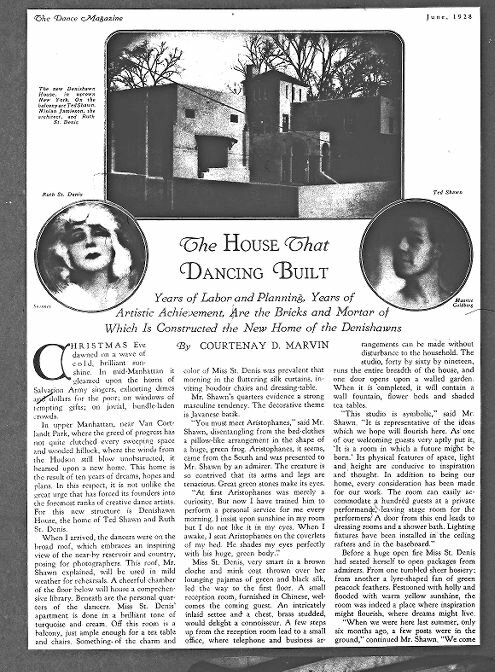Denishawn House: The gem in Van Cortlandt Village
The home of modern dance visionaries holds lots of stories
Almost lost about the talk of the Van Cortlandt Jewish Center’s fate is the historical gem located on the same lot on Stevenson Place. One neighbor called it the “crucible of creative activity that advanced the modern dance movement.”
“Take the Bx10 bus to Stevenson Place and Sedgwick Avenue; walk down the block and you will see the vestiges of Denishawn House perched on a high mound of sloping ground along a cement wall that hugs the corner of Stevenson Place,” wrote Joe Gordon, a neighbor and former journalist who lived across from the house with his family for some time.
“Behind the wall was a garden and outdoor stage where young dancers rehearsed and walked barefoot amidst flowers and plants.”
He goes on to describe how the slopes near the house overlooking the Jerome Park Reservoir once included artists parading in “flowing costumes” and the rooftop where Ruth St. Denis and Ted Shawn “star-gazed and envisioned the future of dance.”
This 97-year-old Moor-styled abode in Van Cortlandt Village is what is left of the Denishawn House and Studio that once housed the modern dance’s “grandparents” Ruth Saint Denis and Ted Shawn. Thus, the name Denishawn House at 67 Stevenson Place located behind the synagogue on Sedgwick Avenue.
“If the Van Cortlandt Jewish Center, which owns the house, goes ahead with the sale of this property to a real estate developer, the Denishawn House will be tossed away like a dusty relic of New York cultural history,” said Gordon, whose family used to live across from the Denishawn House, wrote in an article for The Riverdale Press. “Gone forever will be this unique placemark in the annals of American dance.
“The house could, with the right backing, serve as a unique place, a new venue drawn from the old, where dance is celebrated and taught.”
St. Denis brought eastern ideas into modern dance and performed in vaudeville and musical comedy shows as she danced, according to the Encyclopedia Britannica. Her first dance work was “Radha,” a Hindu-based theatrical work. Her later included “Egypta” (1910) and “O-mika” (1913), a dance drama in a Japanese style. She died at the age of 89 in 1968 while living in Los Angeles.
Shawn got into dance when he was 19 when he was studying to become a minister, he suffered a bout of diphtheria, leaving him temporarily paralyzed, according to Jacob’s Pillow’s website. On the advice of his physician, he took up dance as a form of physical therapy. Dancing cured Shawn’s paralysis and left him with a passion that would guide and direct him for the rest of his life.
It was in 1914 after he was a Metropolitan Opera dancer and achieved some success as part of an exhibition ballroom team that he met St. Denis. They were married that same year. He died at the age of 80 in 1972 in Orlando, Florida.
The couple started out in Los Angeles with the Denishawn School of Dancing and Related Arts before coming to New York City and building what became known as the Denishawn House in 1927. While the campus included a studio, all that remains is the house where the couple lived just before they were separated in 1930.
After they separated, St. Denis remained at the Denishawn House living with some of the dancers while Shawn went off to the Berkshires in Massachusetts to start what was called Jacob’s Pillow, a professional dance training center that still holds performances to this day. The connection between the couple still existed as St. Denis would occasionally perform there and many of the dance costumes would be stored at Denishawn House.
The Denishawn House would become the dream both dancers wanted for themselves.
“Until they had the Denishawn House, they had been very (conservative) with their earnings,” said Norton Owen, director of preservation at Jacob’s Pillow. “They would be in vaudeville tours and do their own shows.
“Eventually, they would turn those earnings into building the Denishawn House. It would be a home for them. It was always a dream of theirs.”
They were heard to tell people that at Denishawn House, “every brick was a one-night stand,” Owen said.
In addition to the building itself, the couple leaves behind a treasure trove of photographs and costumes that could fill up a modern dance museum. At the moment, the New York City Public Library has a large collection of books, photographs, drawings and graphic posters that are part of the Denishawn legacy.
Modern dance fans fear the sale of the Denishawn House property will mean the end of any vestige of the role the couple played in bringing that art to New York City.
“It’s never been landmarked,” Owen said. “ That’s what makes it vulnerable at this time. The studio is no longer there. It ceased to exist some time ago.”
From what he understands, the only person who lives in the house is a caretaker for the Van Cortlandt Jewish Center.
“What a loss it would be were America’s first free-standing house of modern dance to vanish before future generations of dancers had a chance to see it,” Gordon wrote. “Denishawn House belongs on the American dance history map.”










